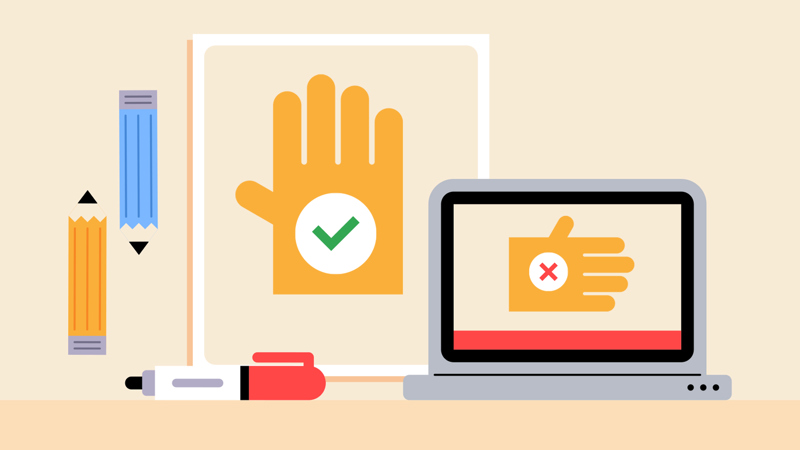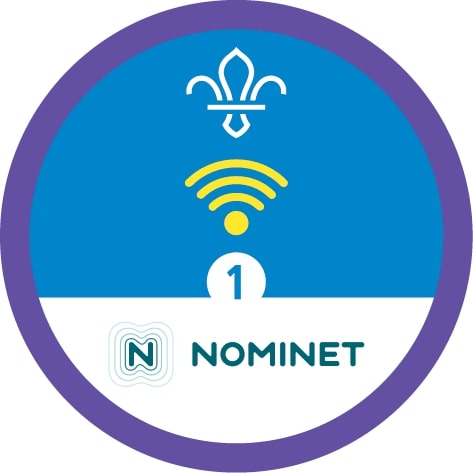
Hands up, hands down
You’ll need
- Device with access to the internet
- A4 paper
- Coloured pens or pencils
- Scissors
Before you begin
- This is a great activity to run during an online session. Check out the advice on using Zoom and other popular digital platforms and the guidance on being safe online.
- Think about how you'll explain the instructions to everyone on the call – you may want to make an example to show everyone, to make it easier to explain.
- Make sure the paper’s thick enough for people to be able to use both sides. Everyone may need to use pencils or crayons (rather than pens) so they don’t bleed through.
Make hands
- The person leading the activity should welcome everyone to the call and check that everyone has the equipment they need ready to go.
- Everyone should put a piece of paper in front of them with the shorter sides at the top and bottom.
- They should put one hand (and around eight centimetres of their arm) on the paper and draw around it with a pencil.
- Everyone should fill their hand with writing and drawings about things that make them unique. They could include things like their family, friends, pets, hobbies, school, interests, faith, holidays, and whatever else is important to them. If there are any spaces, they should fill them with colour or patterns so the hand’s totally full.
- Everyone should cut out their paper hand.
Hands up
- Once everyone's finished decorating their hands, they should take it in turns to lift their hands up to the camera and show them to the group.
- One or two people should talk through their hands and what everything means.
- The person leading the activity should remind everyone that it’s safe to share all of this information in this situation, because it’s a safe space. Everyone should chat about what makes it a safe space.
Hands down
- Everyone should turn their hand over so they’re looking at the blank side.
- Everyone should think about what digital actions they take, things like searches, clicks or posts. They should think of what information they might leave behind as a result of the different actions.
- Now everyone should think about what they’d be comfortable sharing online with someone they don’t know. They should write or draw what they’d be comfortable sharing in this situation.
- Everyone should talk about what they’d be comfortable sharing. The people leading the activity should help everyone decide what’s safe – it might be a bit different depending on everyone’s age and experience.
Reflection
This activity helped everyone to create stronger friendships. Did finding out more about others help people feel more connected? Why is this a safe space to share information and make friends?
This activity also helped everyone to live healthily by keeping themselves safe. There are lots of important things in people’s lives, but they don’t need to share everything with everyone – they can choose which bits of life they share and who they share them with. What would happen if people were online and someone they didn’t know asked them a personal question such as where they lived or what their phone number was? Hopefully people remember that they shouldn’t share this information and should tell a trusted adult. What should people do before they share information about (or photos of) someone online? They should always ask permission – people should check with a trusted adult before they say ‘yes’, and it’s always OK for anyone to say ‘no’ politely and firmly.
Safety
All activities must be safely managed. You must complete a thorough risk assessment and take appropriate steps to reduce risk. Use the safety checklist to help you plan and risk assess your activity. Always get approval for the activity, and have suitable supervision and an InTouch process.
- Scissors
Supervise young people appropriately when they’re using scissors. Store all sharp objects securely, out of the reach of young people.
Make it accessible
All Scout activities should be inclusive and accessible.
People could look at pictures from magazines and newspapers and decide whether it’d be OK to share them online. For example, a photo of a sunset might be OK, but a photo of a stranger wouldn’t be OK because people should never take or post photos of people without their permission.
